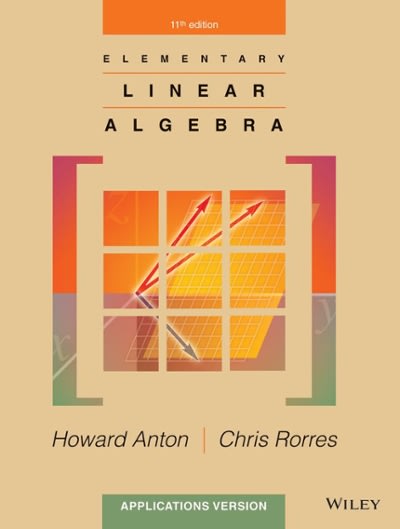Question
Assume n balls having loads vvz, . are in a urn. These balls are successively eliminated in the accompanying way: At every choice, a given
Assume n balls having loads vvz, .
are in a urn. These balls are successively
eliminated in the accompanying way: At every choice, a given ball in the urn is picked witn a
likelihood equivalent to its weight separated by the whole ot the loads of different balls that are still in
the urn. Let
In signify the request wherein the balls are taken outhence 11, 12,
. , In isa
irregular stage with loads.
(a) Give a technique pinnacle reenacting 11, .
(b) Let Xi be free exponentials with rates I
to recreate 11,
, n. Clarify how X/can be used
question 46
Request Statistics: Let X, ,
Xn be i.i.d. from a constant dissemination F, and let Xo mean the
lth littlest ofX1, .
,xn.i-l,
, n Suppose we need to mimic X(IJ < X. < X,n). One
approach is to mimic n esteems trom F, and afterward request these qualities. In any case, this requesting: or
arranging, can be tedious when n is huge.
(a) Suppose that the peril rate capacity of F, is limited. Show how the risk rate
strategy can be applied to produce the n factors in such a way that no arranging is vital.
Assume since Fl is effortlessly processed.
(b) Argue that XIIJ, , Xin) can be created by recreating I-J(l} < 1-42) < U(n) the
requested upsides of n autonomous arbitrary numbersand afterward setting X(i) - FI(UO)). Clarify why
this implies that Xo can be created trom Fl(j) where is beta with boundaries j, n + I + 1.
(c) Argue that I-Jill
exponentials Yl, .
U can be created, with no need pinnacle arranging, by reenacting i.i.d.
. r, and afterward setting
Yl+v..+Yi
+ Yn+l '
n
Clue: Given the time ofthe (n + l)st occasion of a Poisson cycle, the thing can be said about the set
oftimes ofthe first n occasions?
(d) Show that assuming I-J(n} = y, Lili), .
. {n_l) has a similar joint circulation as the request
insights of a bunch of n - 1 uniform (O, y) irregular factors.
(e) use part (d) to show that (JO},
I-Jin
Step f: Generate arbitrary numbers .
Stage 2: Set
l/n
1
1/0-1)
can be created as follows:
question 47
Assume we need to reproduce an enormous number n of free exponentials with rate Icall
them Xl, X2,
, Xn If we were to utilize the backwards change procedure we would require one
logarithmic calculation for every dramatic produced. One approach to stay away from this is to initially reproduce
Sm a gamma irregular variable with boundaries (n, 1) (say, by the technique for Section 11.3.3). Presently
decipher Sn as the hour of the nth occasion ofa Poisson measure with rate 1 and utilize the outcome that
given Sn the arrangement of the principal n-1 occasion times is appropriated as the arrangement of n 1 free
uniform irregular factors. aased on this, clarify why the follovving calculation reenacts n
free exponentials:
Step f: Generate Sn, a gamma irregular variable vvith boundaries (n, 1).
Stage 2: Generate n - 1 irregular numbers Ul, LJ2,
Stage 3: Order the Ui, I = 1,
n 1 to acquire I-J(l} < 1-42) < U
Stage 4: Let = O, I-Jinj = 1, and set Sn(Uj-Uc,_ I
At the point when the requesting (stage 3) is performed by the calculation depicted in Section 11.5, the
going before is a proficient technique for reenacting n exponentials when all n are all the while
required. It memory space is restricted, in any case, and the exponentials can be utilized
consecutively, disposing of every remarkable from memory whenever it has been utilized, at that point the
going before may not be fitting.
question 48
Consider the accompanying calculation peak producing an irregular stage ot the components 1, 2,
n. In this calculation, PO) can be deciphered as the component in position I.
Step f: Set 1.
Stage 2: Set 1.
Stage 3: If k= n, stop. Othenvise, let k+ 1.
Stage 4: Generate an arbitrary number U, and let
crap = + 1),
Go to stage 3.
(a) Explain in words what the calculation is doing.
(b) Show that at cycle kthat is: the point at which the worth of P(k) is at first setthat
P(l), P(l), P(k) is an irregular change of 1, 2,
Clue: use enlistment and contend that
Pk{il, 12,
.jil
Jk-2, 0
1
Jk-2, 0
by the enlistment speculation
The previous calculation can be utilized regardless of whether n isn't at first known.
Step by Step Solution
There are 3 Steps involved in it
Step: 1

Get Instant Access to Expert-Tailored Solutions
See step-by-step solutions with expert insights and AI powered tools for academic success
Step: 2

Step: 3

Ace Your Homework with AI
Get the answers you need in no time with our AI-driven, step-by-step assistance
Get Started


